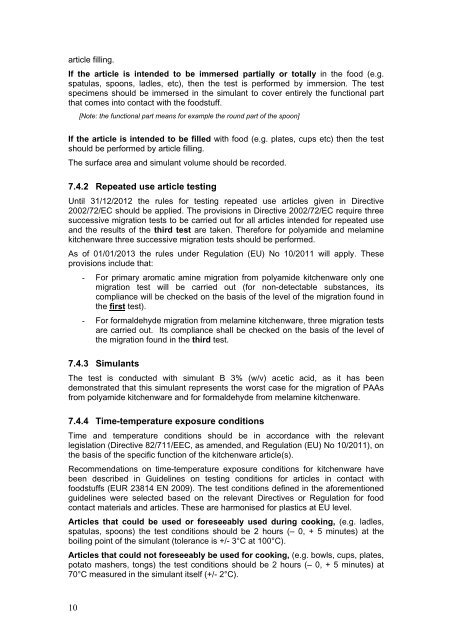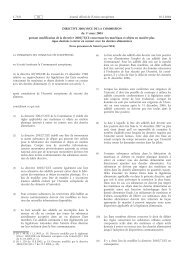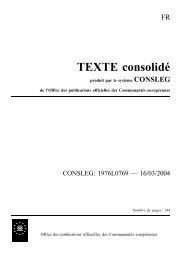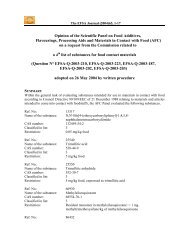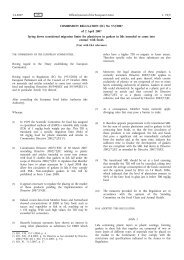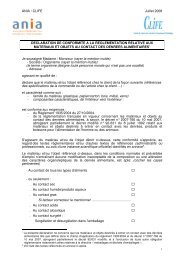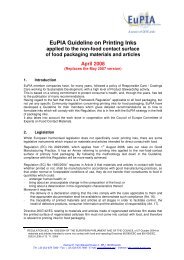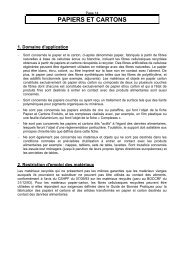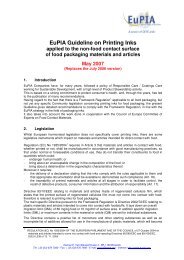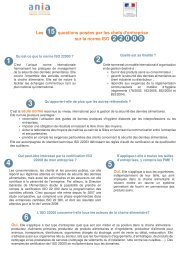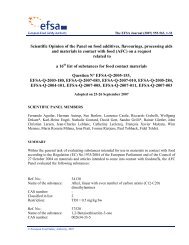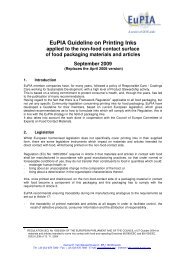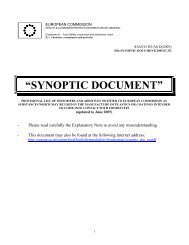Technical guidelines on testing the migration of primary aromatic ...
Technical guidelines on testing the migration of primary aromatic ...
Technical guidelines on testing the migration of primary aromatic ...
You also want an ePaper? Increase the reach of your titles
YUMPU automatically turns print PDFs into web optimized ePapers that Google loves.
article filling.If <strong>the</strong> article is intended to be immersed partially or totally in <strong>the</strong> food (e.g.spatulas, spo<strong>on</strong>s, ladles, etc), <strong>the</strong>n <strong>the</strong> test is performed by immersi<strong>on</strong>. The testspecimens should be immersed in <strong>the</strong> simulant to cover entirely <strong>the</strong> functi<strong>on</strong>al partthat comes into c<strong>on</strong>tact with <strong>the</strong> foodstuff.[Note: <strong>the</strong> functi<strong>on</strong>al part means for example <strong>the</strong> round part <strong>of</strong> <strong>the</strong> spo<strong>on</strong>]If <strong>the</strong> article is intended to be filled with food (e.g. plates, cups etc) <strong>the</strong>n <strong>the</strong> testshould be performed by article filling.The surface area and simulant volume should be recorded.7.4.2 Repeated use article <strong>testing</strong>Until 31/12/2012 <strong>the</strong> rules for <strong>testing</strong> repeated use articles given in Directive2002/72/EC should be applied. The provisi<strong>on</strong>s in Directive 2002/72/EC require threesuccessive migrati<strong>on</strong> tests to be carried out for all articles intended for repeated useand <strong>the</strong> results <strong>of</strong> <strong>the</strong> third test are taken. Therefore for polyamide and melaminekitchenware three successive migrati<strong>on</strong> tests should be performed.As <strong>of</strong> 01/01/2013 <strong>the</strong> rules under Regulati<strong>on</strong> (EU) No 10/2011 will apply. Theseprovisi<strong>on</strong>s include that:- For <strong>primary</strong> <strong>aromatic</strong> amine migrati<strong>on</strong> from polyamide kitchenware <strong>on</strong>ly <strong>on</strong>emigrati<strong>on</strong> test will be carried out (for n<strong>on</strong>-detectable substances, itscompliance will be checked <strong>on</strong> <strong>the</strong> basis <strong>of</strong> <strong>the</strong> level <strong>of</strong> <strong>the</strong> migrati<strong>on</strong> found in<strong>the</strong> first test).- For formaldehyde migrati<strong>on</strong> from melamine kitchenware, three migrati<strong>on</strong> testsare carried out. Its compliance shall be checked <strong>on</strong> <strong>the</strong> basis <strong>of</strong> <strong>the</strong> level <strong>of</strong><strong>the</strong> migrati<strong>on</strong> found in <strong>the</strong> third test.7.4.3 SimulantsThe test is c<strong>on</strong>ducted with simulant B 3% (w/v) acetic acid, as it has beendem<strong>on</strong>strated that this simulant represents <strong>the</strong> worst case for <strong>the</strong> migrati<strong>on</strong> <strong>of</strong> PAAsfrom polyamide kitchenware and for formaldehyde from melamine kitchenware.7.4.4 Time-temperature exposure c<strong>on</strong>diti<strong>on</strong>sTime and temperature c<strong>on</strong>diti<strong>on</strong>s should be in accordance with <strong>the</strong> relevantlegislati<strong>on</strong> (Directive 82/711/EEC, as amended, and Regulati<strong>on</strong> (EU) No 10/2011), <strong>on</strong><strong>the</strong> basis <strong>of</strong> <strong>the</strong> specific functi<strong>on</strong> <strong>of</strong> <strong>the</strong> kitchenware article(s).Recommendati<strong>on</strong>s <strong>on</strong> time-temperature exposure c<strong>on</strong>diti<strong>on</strong>s for kitchenware havebeen described in Guidelines <strong>on</strong> <strong>testing</strong> c<strong>on</strong>diti<strong>on</strong>s for articles in c<strong>on</strong>tact withfoodstuffs (EUR 23814 EN 2009). The test c<strong>on</strong>diti<strong>on</strong>s defined in <strong>the</strong> aforementi<strong>on</strong>ed<str<strong>on</strong>g>guidelines</str<strong>on</strong>g> were selected based <strong>on</strong> <strong>the</strong> relevant Directives or Regulati<strong>on</strong> for foodc<strong>on</strong>tact materials and articles. These are harm<strong>on</strong>ised for plastics at EU level.Articles that could be used or foreseeably used during cooking, (e.g. ladles,spatulas, spo<strong>on</strong>s) <strong>the</strong> test c<strong>on</strong>diti<strong>on</strong>s should be 2 hours (– 0, + 5 minutes) at <strong>the</strong>boiling point <strong>of</strong> <strong>the</strong> simulant (tolerance is +/- 3°C at 100°C).Articles that could not foreseeably be used for cooking, (e.g. bowls, cups, plates,potato mashers, t<strong>on</strong>gs) <strong>the</strong> test c<strong>on</strong>diti<strong>on</strong>s should be 2 hours (– 0, + 5 minutes) at70°C measured in <strong>the</strong> simulant itself (+/- 2°C).10


